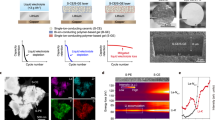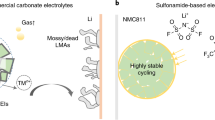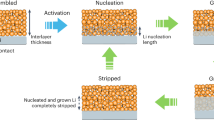Abstract
Although widely used, the most promising Li-based technologies still suffer from a lack of suitable electrodes. There is therefore a need to seek new materials concepts to satisfy the increasing demands for energy storage worldwide. Here we report on a new layered electrode material, Cu2.33V4O11, which shows a sustainable reversible capacity of 270 mA h g−1 at a voltage of about 2.7 V, and electrochemically reacts with Li in an unusual and spectacular way. The reaction entails a reversible Li-driven displacement process leading to the growth and disappearance of Cu dendrites with a concomitant reversible decomposition and recrystallization of the initial electrode material. We show from structural considerations that the uniqueness of Cu2.33V4O11 is rooted in the peculiar flexibility of the stacked [V4O11]n layers, which is due to the presence of pivot oxygen atoms. Fully reversible displacement reactions could provide a new direction for developing an alternative class of higher energy density Li storage electrodes.
This is a preview of subscription content, access via your institution
Access options
Subscribe to this journal
Receive 12 print issues and online access
$259.00 per year
only $21.58 per issue
Buy this article
- Purchase on Springer Link
- Instant access to full article PDF
Prices may be subject to local taxes which are calculated during checkout






Similar content being viewed by others
References
Poizot, P., Laruelle, S., Grugeon, S., Dupont, L. & Tarascon, J.-M. Nano-sized transition metal oxides as negative electrode material for lithium-ion batteries. Nature 407, 496–499 (2000).
Poizot, P., Laruelle, S., Grugeon, S. & Tarascon, J.-M. Rationalization of the low-potential reactivity of 3D-metal-based inorganic compounds toward Li. J. Electrochem. Soc. 149, A1212–A1217 (2002).
Obrovac, M.N., Dunlap, R.A., Sanderson, R.J. & Dahn, R.J. The electrochemical displacement reaction of lithium with metal oxides. J. Electrochem. Soc. 148, A576–A588 (2001).
Pralong, V., Souza, D.S.C., Leung, T. & Nazar, L.F. The mechanism of reversible lithium uptake in CoP3 at low potential: role of the anion. Electrochem. Commun. 4, 516–520 (2002).
Pereira, N., Dupont, L., Tarascon, J.-M., Klein, L.C. & Amatucci, G.G. The electrochemistry of Cu3N with lithium, a complex system with parallel processes. J. Electrochem. Soc. 150, A1273–A1280 (2003).
Li, H., Richter, G. & Maier, J. Reversible formation and decomposition of Li clusters using transition metal fluorides as precursors and their application in rechargeable Li batteries. Adv. Mater. 15, 736–739 (2002).
Badway, F., Pereira, N., Cosandey, F. & Amatucci, G.G. Carbon metal fluoride nanocomposites: high capacity reversible metal fluoride conversion materials as rechargeable positive electrodes for Li batteries. J. Electrochem. Soc. 150, A1318–A1327 (2003).
Kepler, K.D., Vaughey, J.T. & Thackeray, M.M. LixCu6Sn5 (0 < x < 13): an intermetallic insertion electrode for rechargeable lithium batteries. Electrochem. Solid State Lett. 7, 307–309 (1999).
Fransson, L.M.L. et al. Phase transitions in lithiated Cu2Sb anodes for lithium batteries: an in situ X-ray diffraction study. Electrochem. Commun. 3, 317–323 (2001).
Tostmann, H., Kropf, A.J., Johson, C.S., Vaughey, J.T. & Thackeray M.M. In situ x-ray absorption studies of electrochemically induced phase changes in lithium-doped InSb. Phys. Rev. B. 66, 014106 (2002).
Brec, R., Prouzet, E. & Ouvrard, G. Transition metal displacement in cathodic host structures upon lithium intercalation. J. Power Sources 43–44, 277–288 (1993).
Takeda, Y., Kanno, R., Noda, M. & Yamamoto, O. Lithium organic electrolyte cells using the copper chevrel phase as cathode. Mater. Res. Bull. 20, 71–77 (1985).
McKinnon, W.R. & Dahn, J.R. Salting out in intercalation compounds: removing copper from Cu3Mo6S8 by interacting Li. Solid State Commun. 52, 245–248 (1984).
Tarascon, J.-M., Orlando, T.P. & Neal, M.J. Rechargeable lithium batteries based on the ternary chevrel phase AgMo6S8 as the cathode. J. Electrochem. Soc. 135, 804–809 (1988).
Eguchi, M., Iwamoto, T., Miura, T. & Kishi, T. Lithiation characteristics of α-CuV2O6 and other nCuO.V2O5 oxides. Solid State Ionics 89, 109–116 (1996).
Sakurai, Y. & Yamaki, J.-I. Electrochemical reaction of α-Cu2V2O7 with lithium in organic electrolyte. Electrochem. Acta 34, 355–361 (1989).
Ilic, D. & Neumann, D. Characterization of Cu2V2O7 as cathode material for lithium cells by X-ray and photoelectron spectroscopy. J. Power Sources 43–44, 589–593 (1993).
Giorgetti, M., Mukerjee, S., Passerini, S., McBreen, J. & Smyrl, W.H. Evidence for reversible formation of metallic Cu in Cu0.1V2O5 xerogel cathodes during intercalation cycling of Li+ ions as detected by X-ray absorption spectroscopy. J. Electrochem. Soc. 148, A768–A774 (2001).
Galy, J. Vanadium pentoxide and vanadium oxide bronzes — structural chemistry of singles (S) and double (D) layers MxV2O5 phases. J. Solid State Chem. 100, 229–245 (1992).
Withers, R., Millet, P. & Tabira, Y. The inherent displacive structural flexibility of MxV2O5 framework structures. Z. Kristallogr. 215, 357–363 (2000).
Rozier, P., Satto, C. & Galy, J. The vanadium oxide bronze Cu2.33−xV4O11. Solid state chemistry, XRD. Solid State Sci. 2, 595–605 (2000).
Badway, F. et al. Metal oxides as negative electrodes from Li-ion cells. Electrochem. Solid State Lett. 5, A115–A118 (2002).
Chung, S.-Y., Bloking, J.T. & Chiang, Y.-M. Electronically conductive phospho-olivines as lithium storage electrodes. Nature Mater. 1, 123–128 (2002).
Dollé, M., Sannier, L., Beaudoin, B., Trentin, M. & Tarascon, J.-M. Live scanning electron microscope observations of dendritic growth in lithium/polymer cells. Electrochem. Solid State Lett. 5, A286–A289 (2002).
Rozier, P. & Lidin, S. The composite structure of Cu2.33−xV4O11 . J. Solid State Chem. 172, 319–326 (2003).
Rozier, P., Galy, J., Chelkowska, G., Kooh, H.-J. & Whangbo, M.-H. Electrical resistivity, magnetic susceptibility, X-ray photoelectron spectroscopy and electronic band structure studies of Cu2.33V4O11 J. Solid State Chem. 166, 382–388 (2002).
Roisnel, T. & Rodriguez-Carvajal, J. WinPLOTR, downloadable at http://www-llb.cea.fr/fullweb/powder.htm
Tarascon, J.-M., Gozdz, A.S., Schmutz, C., Shokoohi, F. & Warren, P.C. Performance of Bellcore's plastic rechargeable Li-ion batteries. Solid State Ionics 86–88, 49–54 (1996).
Acknowledgements
We thank M. G. Karkut, D. Larcher, P. Poizot and B. Beaudoin for many useful discussions.
Author information
Authors and Affiliations
Corresponding author
Ethics declarations
Competing interests
The authors declare no competing financial interests.
Rights and permissions
About this article
Cite this article
Morcrette, M., Rozier, P., Dupont, L. et al. A reversible copper extrusion–insertion electrode for rechargeable Li batteries. Nature Mater 2, 755–761 (2003). https://doi.org/10.1038/nmat1002
Received:
Accepted:
Published:
Issue Date:
DOI: https://doi.org/10.1038/nmat1002
This article is cited by
-
Anion redox as a means to derive layered manganese oxychalcogenides with exotic intergrowth structures
Nature Communications (2023)
-
Copper diffusion related phase change and voltage decay in CuS cathode
Nano Research (2023)
-
Is there a common reaction pathway for chromium sulfides as anodes in sodium-ion batteries? A case study about sodium storage properties of MCr2S4 (M = Cr, Ti, Fe)
Journal of Solid State Electrochemistry (2022)
-
Ag2V4O11: from primary to secondary battery
Journal of Solid State Electrochemistry (2022)
-
Rechargeable Aqueous Zinc-Ion Batteries in MgSO4/ZnSO4 Hybrid Electrolytes
Nano-Micro Letters (2020)



